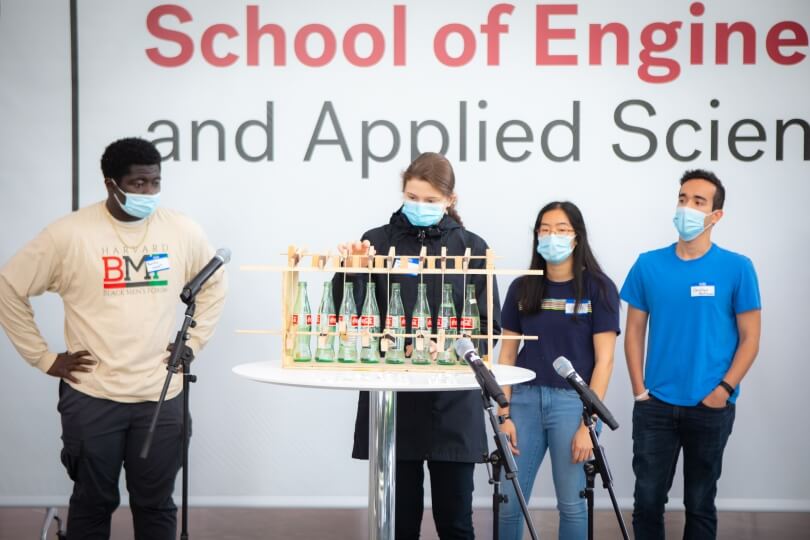News
Ever tried to make a ukulele out of a gourd? How about a lute from a salad bowl? A piano from a bunch of glass soda bottles?
Those were some of the instruments students at the Harvard John A. Paulson School of Engineering and Applied Sciences (SEAS) created and demonstrated at the Symphosium at the Science and Engineering Complex atrium. It was the final project of the semester for “AP50: Physics as a Foundation for Science and Engineering.”
Twenty-nine teams of students, led by Eric Mazur, the Balkanski Professor of Physics and Applied Physics at SEAS, put their instruments on display on Dec. 6. They turned the SEC atrium into an orchestra of glass bottles, copper tubes, plastic cups, wooden blocks, guitar strings, rubber bands and duct tape.
The goal: create an instrument using found or recycled materials, one which could be easily recreated at a school in a developing country or with limited resources.
“The wood is literally just from the scrap bins in the lab,” Jamie Menhal, ‘24, said of his team’s winning instrument. “Just nails, hammers, a little bit of glue, and some empty glass bottles courtesy of recycling bins.”
The class’s approach was inspired by José Antonio Abreu, who received an honorary doctorate from Harvard in 2013, and his groundbreaking efforts to bring music education to children in resource-deprived areas of Venezuela.
The four winning teams were determined by popular vote, gaining the most red, white or blue tickets from their classmates and registered attendees.
Most Educational
The “Most Educational” award went to the quartet of Melissa Jones (‘24), Matthew Mansour (‘24), Alex Rene (‘23) and Menhall. The “Sonorous Scientists,” as their team was called, were one of several teams to build an instrument out of water-filled glass bottles. They mounted five bottles in a wooden frame, varying the water level within to change the note each bottle played when struck.
“We tried to put in a good amount of time to understand Hemholz resonance, and why going from full to a half-bottle would change the frequency,” Jones said. “We paid less than a dollar for the whole project. I think the coolest part is that in Venezuela, these glass bottles are even more commonly used.”
From left, Kwaku Adubofour (‘24), Victoria Levy (‘25), Sophia Liang (‘23) and Christian Rodriguez (‘23) present their instrument at the end-of-semester Symphosium concert on Dec. 6 in the Science and Engineering Complex Atrium in Allston. (Credit: Eliza Grinnell/Seas)
Most Original
Kwaku Adubofour (‘24), Victoria Levy (‘25), Sophia Liang (‘23) and Christian Rodriguez (‘23) built a piano using glass soda bottles, each of which was placed next to a wooden block with a nail hammered into it.
Each block was then attached via string to another block higher up in the frame. Striking the higher block caused the lower one to draw back and strike the bottle, mimicking how piano keys cause tiny hammers to hit the corresponding strings and play notes.
“Instead of replicating instruments that we were already familiar with, we were trying to come up with our own designs,” Liang said. “It’s not like, ‘How can we build a miniature piano,’ but how we make a piano-like mechanism with different materials.”
The second “Most Original” award went to Ayah Al-Zubi (‘24), Matthew Garcia (‘23), Abdullah Bannan (‘23) and Destiny Rochester (‘22), who strung rubber bands around a plastic cup to create a stringed instrument. The group described their instrument as something that could help young musicians practice the fine motor movement associated with fingering for stringed instruments.
Cade Herrera ('23), center, plays his lute made from a salad bowl in front of teammates Joshua Kim (‘24) and Charis Palandjian (‘23) at the end-of-semester Symphosium presentation on Dec. 6 in the Science and Engineering Complex Atrium. (Credit: Eliza Grinnell/SEAS)
Best Performance
Teams had the option to play their instruments live at the atrium. Most of the groups played simple children’s songs such as “Hot Cross Buns” or “Mary Had a Little Lamb,” but winning Best Performance took a little extra.
Specifically, it took “Love Story” by Taylor Swift, played on an oversized lute built out of a salad bowl.
“The strings are super high up from the fingerboard, so the intonation can be super variable,” said Cade Herrera, ‘23, who performed the 2008 Swift single. “It really depends on where you put your fingers, and how much vibrato you use.”
The lute, designed by Jasmine Adams (‘24), Joshua Kim (‘24), Charis Palandjian (‘23) and Herrera, consisted of a wooden neck and front mounted to a large wooden salad bowl, which acted as the body.
“Because the strings are holding so much tension, the top part that we screwed the pegs onto broke one time and snapped off,” Palandjian said. “We added this thing in the back that reinforces it, but that was the hardest part.”
Topics: Applied Physics
Cutting-edge science delivered direct to your inbox.
Join the Harvard SEAS mailing list.
Press Contact
Matt Goisman | mgoisman@g.harvard.edu




